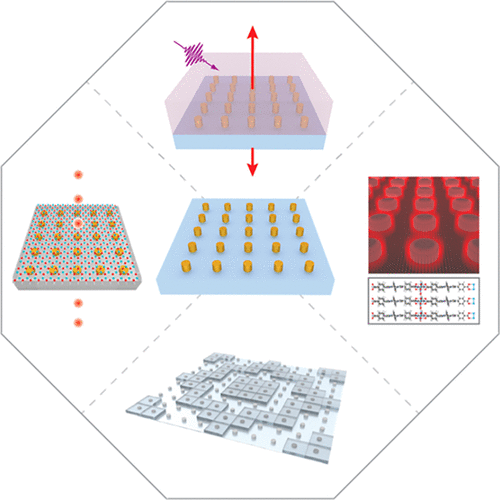当前位置:
X-MOL 学术
›
Acc. Chem. Res.
›
论文详情
Our official English website, www.x-mol.net, welcomes your
feedback! (Note: you will need to create a separate account there.)
Manipulating Light-Matter Interactions in Plasmonic Nanoparticle Lattices.
Accounts of Chemical Research ( IF 16.4 ) Pub Date : 2019-10-09 , DOI: 10.1021/acs.accounts.9b00345 Danqing Wang , Jun Guan , Jingtian Hu , Marc R. Bourgeois , Teri W. Odom
Accounts of Chemical Research ( IF 16.4 ) Pub Date : 2019-10-09 , DOI: 10.1021/acs.accounts.9b00345 Danqing Wang , Jun Guan , Jingtian Hu , Marc R. Bourgeois , Teri W. Odom

|
Rationally assembled nanostructures exhibit distinct physical and chemical properties beyond their individual units. Developments in nanofabrication techniques have enabled the patterning of a wide range of nanomaterial designs over macroscale (>in.2) areas. Periodic metal nanostructures show long-range diffractive interactions when the lattice spacing is close to the wavelength of the incident light. The collective coupling between metal nanoparticles in a lattice introduces sharp and intense plasmonic surface lattice resonances, in contrast to the broad localized resonances from single nanoparticles. Plasmonic nanoparticle lattices exhibit strongly enhanced optical fields within the subwavelength vicinity of the nanoparticle unit cells that are 2 orders of magnitude higher than that of individual units. These intense electromagnetic fields can manipulate nanoscale processes such as photocatalysis, optical spectroscopy, nonlinear optics, and light harvesting. This Account focuses on advances in exciton-plasmon coupling and light-matter interactions with plasmonic nanoparticle lattices. First, we introduce the fundamentals of ultrasharp surface lattice resonances; these resonances arise from the coupling of the localized surface plasmons of a nanoparticle to the diffraction mode from the lattice. Second, we discuss how integrating dye molecules with plasmonic nanoparticle lattices can result in an architecture for nanoscale lasing at room temperature. The lasing emission wavelength can be tuned in real time by adjusting the refractive index environment or varying the lattice spacing. Third, we describe how manipulating either the shape of the unit cell or the lattice geometry can control the lasing emission properties. Low-symmetry plasmonic nanoparticle lattices can show polarization-dependent lasing responses, and multiscale plasmonic superlattices-finite patches of nanoparticles grouped into microscale arrays-can support multiple plasmon resonances for controlled multimodal nanolasing. Fourth, we discuss how the assembly of photoactive emitters on the nanocavity arrays behaves as a hybrid materials system with enhanced exciton-plasmon coupling. Positioning metal-organic framework materials around nanoparticles produces mixed photon modes with strongly enhanced photoluminescence at wavelengths determined by the lattice. Deterministic coupling of quantum emitters in two-dimensional materials to plasmonic lattices leads to preserved single-photon emission and reduced decay lifetimes. Finally, we highlight emerging applications of nanoparticle lattices from compact, fully reconfigurable imaging devices to solid-state emitter structures. Plasmonic nanoparticle lattices are a versatile, scalable platform for tunable flat optics, nontrivial topological photonics, and modified chemical reactivities.
中文翻译:

操纵等离子纳米粒子晶格中的光物质相互作用。
合理组装的纳米结构在其单个单元之外展现出独特的物理和化学特性。纳米制造技术的发展使得能够在宏观(> in.2)区域内对各种纳米材料设计进行图案化。当晶格间距接近入射光的波长时,周期性的金属纳米结构表现出长距离的衍射相互作用。与单个纳米颗粒的广泛局部共振相反,晶格中的金属纳米颗粒之间的集体耦合引入了尖锐而强烈的等离子体表面晶格共振。等离子体纳米颗粒晶格在纳米颗粒晶胞的亚波长范围内表现出强烈增强的光场,该光场比单个晶胞的光场高2个数量级。这些强电磁场可以操纵纳米级过程,例如光催化,光谱,非线性光学和光收集。该帐户着重于激子-等离激元耦合以及与等离激元纳米粒子晶格的光物质相互作用方面的进展。首先,我们介绍了超锐利的表面晶格共振的基本原理;这些共振是由于纳米粒子的局部表面等离子体激元与晶格的衍射模式的耦合而产生的。其次,我们讨论将染料分子与等离子体纳米颗粒晶格整合在一起如何在室温下产生纳米级激光的体系结构。可以通过调整折射率环境或改变晶格间距来实时调整激光发射波长。第三,我们描述了如何操纵晶胞的形状或晶格几何形状如何控制激光发射特性。低对称等离子纳米粒子晶格可以显示偏振相关的激射响应,并且多尺度等离子超晶格有限的纳米粒子斑块(分组为微尺度阵列)可以支持多个等离振子共振,以控制多模态纳米激光。第四,我们讨论了纳米腔阵列上光敏发射体的组装如何表现为具有增强的激子-等离子体耦合的混合材料系统。将金属有机框架材料放置在纳米粒子周围会产生混合光子模式,并在由晶格确定的波长下具有大大增强的光致发光。二维材料中的量子发射器与等离激元晶格的确定性耦合会导致保留的单光子发射并降低衰减寿命。最后,我们重点介绍了从紧凑的,可完全重新配置的成像设备到固态发射器结构的纳米粒子晶格的新兴应用。等离子体等离子纳米晶格是一种多功能的,可扩展的平台,用于可调平面光学器件,非平凡的拓扑光子学和改良的化学反应性。
更新日期:2019-10-10
中文翻译:

操纵等离子纳米粒子晶格中的光物质相互作用。
合理组装的纳米结构在其单个单元之外展现出独特的物理和化学特性。纳米制造技术的发展使得能够在宏观(> in.2)区域内对各种纳米材料设计进行图案化。当晶格间距接近入射光的波长时,周期性的金属纳米结构表现出长距离的衍射相互作用。与单个纳米颗粒的广泛局部共振相反,晶格中的金属纳米颗粒之间的集体耦合引入了尖锐而强烈的等离子体表面晶格共振。等离子体纳米颗粒晶格在纳米颗粒晶胞的亚波长范围内表现出强烈增强的光场,该光场比单个晶胞的光场高2个数量级。这些强电磁场可以操纵纳米级过程,例如光催化,光谱,非线性光学和光收集。该帐户着重于激子-等离激元耦合以及与等离激元纳米粒子晶格的光物质相互作用方面的进展。首先,我们介绍了超锐利的表面晶格共振的基本原理;这些共振是由于纳米粒子的局部表面等离子体激元与晶格的衍射模式的耦合而产生的。其次,我们讨论将染料分子与等离子体纳米颗粒晶格整合在一起如何在室温下产生纳米级激光的体系结构。可以通过调整折射率环境或改变晶格间距来实时调整激光发射波长。第三,我们描述了如何操纵晶胞的形状或晶格几何形状如何控制激光发射特性。低对称等离子纳米粒子晶格可以显示偏振相关的激射响应,并且多尺度等离子超晶格有限的纳米粒子斑块(分组为微尺度阵列)可以支持多个等离振子共振,以控制多模态纳米激光。第四,我们讨论了纳米腔阵列上光敏发射体的组装如何表现为具有增强的激子-等离子体耦合的混合材料系统。将金属有机框架材料放置在纳米粒子周围会产生混合光子模式,并在由晶格确定的波长下具有大大增强的光致发光。二维材料中的量子发射器与等离激元晶格的确定性耦合会导致保留的单光子发射并降低衰减寿命。最后,我们重点介绍了从紧凑的,可完全重新配置的成像设备到固态发射器结构的纳米粒子晶格的新兴应用。等离子体等离子纳米晶格是一种多功能的,可扩展的平台,用于可调平面光学器件,非平凡的拓扑光子学和改良的化学反应性。


















































 京公网安备 11010802027423号
京公网安备 11010802027423号